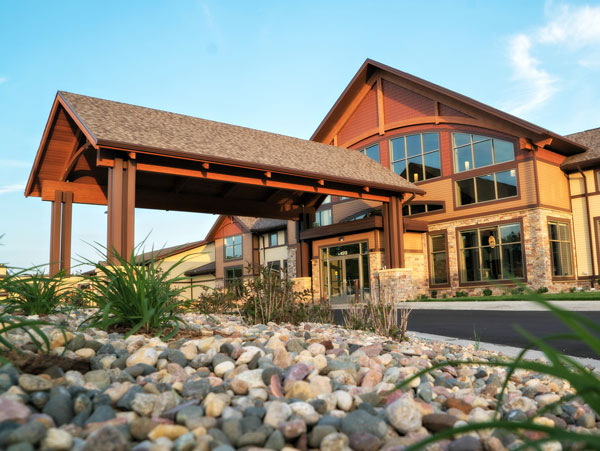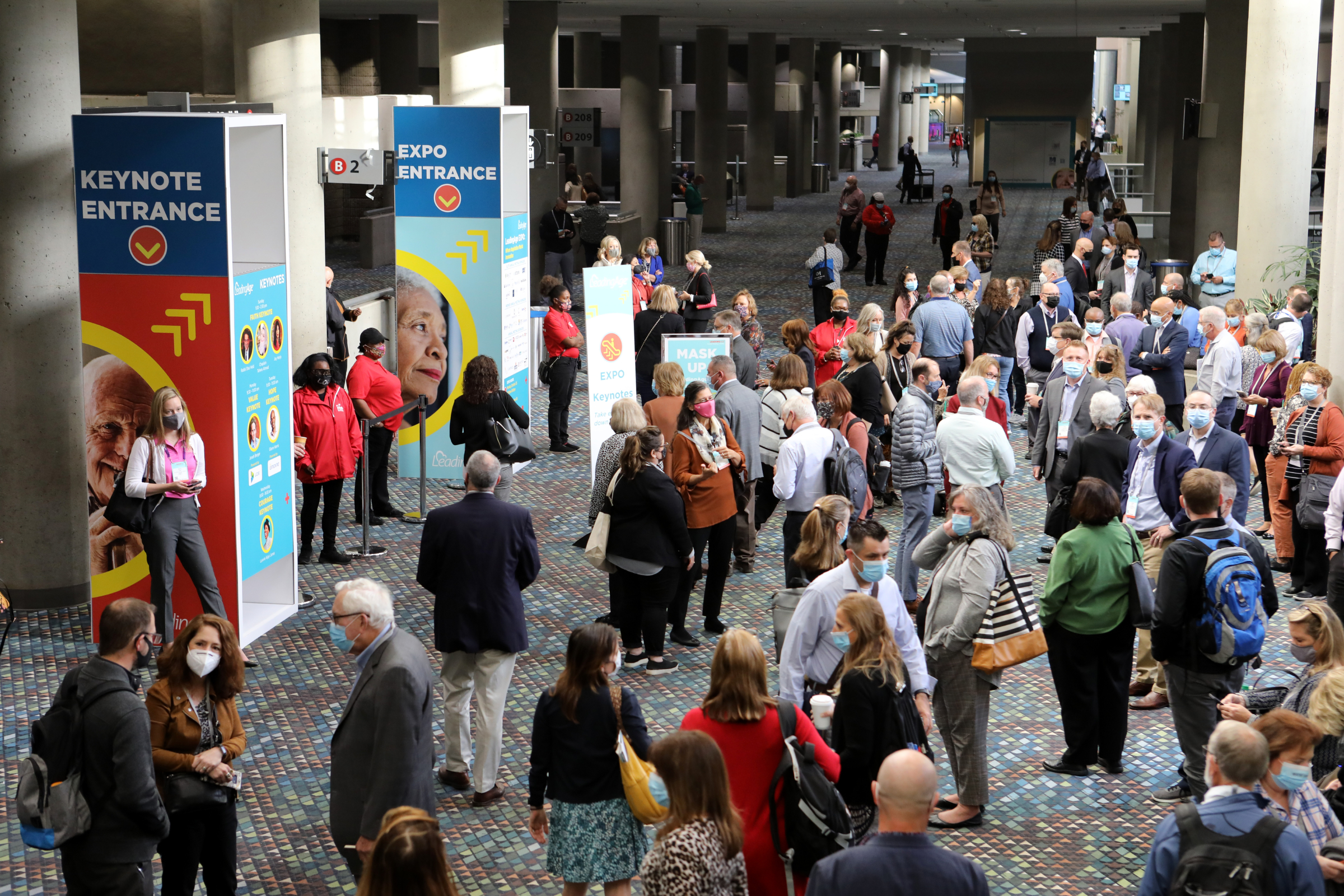January 2019’s LeadingAge Catalyst
January 2019’s LeadingAge Catalyst
Avera Prince of Peace Retirement Community
Sioux Falls, SD

Innovation in Building a Health Care Continuum
Avera Prince of Peace Retirement Community offers a familiar continuum of services—skilled nursing and rehabilitation, assisted living, and independent living for its 250-plus residents.
But the organization extends its health services continuum beyond the norm: Prince of Peace also offers on-site hospice suites, specialized behavioral health services for older adults, and the new Beacom Transitional Care Unit, which offers post-acute care to people of all ages dealing with difficult medical conditions and/or financial hardship.
The community is affiliated with Avera Health, which now operates 33 hospitals, 40 senior living communities, and more than 200 clinics in 5 upper Midwestern states. Prince of Peace’s offerings uphold Avera’s mission “to make a positive impact in the lives and health of persons and communities by providing quality services guided by Christian values.”
We talked with Administrator Justin Hinker about Avera Prince of Peace’s impressive continuum of care.
LeadingAge: Can you offer a brief history of Avera Prince of Peace Retirement Community?
Justin Hinker: We started as a skilled nursing community in 1986, built by Presentation Health System. In the 1990s, Presentation and the Benedictine Health System merged to become Avera.
It started adding assisted living in 1995, as well as independent living, which was built in 3 phases: in 1988, 1990, and 1993. When I arrived in December 2007, the campus had 90 skilled beds, 32 assisted living apartments, and 74 independent living apartments. In addition, the Dougherty Hospice House was open, which has 16 inpatient suites. I don’t supervise that, but it’s on our campus and we support them, covering housekeeping, maintenance, and food services.
By 2015, we identified the need to upgrade. We had a lot of semiprivate rooms, and the building was dated, so we thought about updating the old building, remodeling, or adding a wing, and we ultimately decided to build a new [building] on the same campus. So while occupying the old building, we built 90 new skilled nursing beds and 20 new assisted living beds. We kept the old assisted living and independent living, and added to them.
LeadingAge: Was that an addition of 90 skilled?
Justin Hinker: No. We have a moratorium on new nursing home beds in the state, so we just moved the skilled residents from the old space to the new building. The old building was then vacant.
Probably a year and a half after that, Avera, which has a behavioral health hospital in Sioux Falls, moved the [older adult] part of the behavioral health program out to one of our old wings. Our old nursing [space] is now occupied by that unit, with 14 acute care behavioral health beds.
During the same time we had vacant space, so the state put out an RFP for additional nursing beds. This led to the addition of 24 nursing beds in the old building, remodeled to provide skilled nursing care for those who struggle to find placement in skilled nursing, whether because of acuity or no payer source. [This is the Beacom Transitional Care Unit.]
We really pitch the full continuum of care. Once you move to our campus we can help you navigate through any health care needs you may have.
LeadingAge: What is the role of the Beacom Transitional Care Unit?
Justin Hinker: It has a very diverse population. These are individuals who were in an acute care setting and have a hard time being placed: There might be no payer source, or they may have a high-acuity condition. Ages range from 20 to 80. Some people are here for a shorter term, some a longer term. There is a lot of diversity of ethnicity, and some non-English-speaking residents. It’s a little different from our new, more traditional [skilled nursing] building, which has an average age of 84-87.
LeadingAge: How are patients referred to the Beacom unit?
Justin Hinker: People are referred to us through the acute care hospitals in our area. Typically these are people who would have stayed in an acute care setting until they are able to be discharged.
LeadingAge: So if this unit didn’t exist, they would have to stay in the hospital?
Justin Hinker: Yes, for the most part. If they couldn’t get them discharged they would probably stay there an extended period of time. Now there’s an outlet for them, to come to us. We have 2 wings, 12 and 12. About 12 people are there for the long term, and 12 others have a discharge plan, for shorter duration. We do our best to try to keep that mix. We provide therapy and try to get them home, or maybe to another assisted living.
LeadingAge: What are the funding sources for the Beacom residents?
Justin Hinker: A wide variety. We have some private pay—a small portion. We’ve got some Medicare, some Medicaid, and some that are no-pay.
LeadingAge: I’ve seen that you offer bariatric care there.
Justin Hinker: Yes. Also IV antibiotics, wound care, bariatric care.
LeadingAge: Why do you use the term “transitional care”?
Justin Hinker: Because we already have a wing we call rehab, and we wanted to differentiate this a little. We also didn’t want people to think of it as another long-term care skilled nursing community. We wanted them to think of it as a transition. Ultimately I’d like to achieve the goal of everyone being able to transition out of there at some point. The more we can open up beds for our acute care hospitals, the better.
It’s been challenging at times, but rewarding. We’re taking care of people who really don’t have another place to go, including some homeless individuals.
LeadingAge: Let’s talk about your behavioral health services: Is this unit similar to a memory care unit or is it something more?
Justin Hinker: More. Those 14 beds are acute. These are individuals who are in skilled nursing, and their behaviors are accelerating enough to require an acute care stay to manage those behaviors and their meds.
LeadingAge: Is dementia behind most of those issues?
Justin Hinker: Often, yes, or perhaps a stroke has caused those behaviors. Typically they’ve got aggressive behaviors that can’t be managed [in a typical nursing home] so it will require the expertise of a psychiatrist to manage their meds. There could be residents who are suicidal, so they would also need that next level of care. The staff is specially trained.
LeadingAge: Is that staff provided by the Avera system?
Justin Hinker: Yes. I don’t supervise that area, they are Avera-provided staff, separate from us. We provide support.
LeadingAge: Are those residents referred from outside, or from within your community?
Justin Hinker: Most are coming in from outside. We haven’t had many of our residents that have had to go there. This is the only such unit in Sioux Falls. The same goes for the Beacom unit.
LeadingAge: Re your hospice: Do those patients come in from outside or from your campus?
Justin Hinker: 98% come from the outside. We rarely need to transfer someone over there. We have all private rooms, and we utilize home hospice services already, so they’ll provide it [for our existing residents in their regular LTC rooms.] It’s the Avera System people who run the hospice suites.
One thing that is really helpful is that we can tap the knowledge and services of our acute care hospital. It’s nice to have that connection, to tap the knowledge and expertise that we wouldn’t have access to otherwise.
Another thing I should mention is Avera eCARE—our telehealth service. We have cameras on a cart and can access a physician via telemedicine 24/7. Avera eCARE contracts with hospitals nationwide. We can try to prevent admissions, readmissions, or transitions when possible. Rural areas especially benefit from this. We’ve had it going since 2012. It’s hard to get a program like this started, but the Helmsley Foundation [The Leona M. and Harry B. Helmsley Charitable Trust] gave us a grant to get it started.
LeadingAge: Do you suffer the worker recruitment problems that so many of our members face?
Justin Hinker: Yes. Unemployment in the Sioux Falls area is hovering around 2 percent, so it’s extremely difficult to recruit and retain staff in that environment.
LeadingAge: Have you found any strategies that work?
Justin Hinker: We’ve hosted what we call “Green Carpet Events” (because our color is green). They are open interview events where we advertise that you can come on certain days, apply on site, and we’ll interview you right there. They have been relatively successful. We’ve had upwards of 18 people come to these events. Do they all get hired? No, but we are getting applications. We’re using a lot of retention strategies as well: We interview new staff after 5 days, then 2 weeks, 30 days, 60 days, and 6 months. We ask how it’s going, and “What barriers have you encountered?” We are looking early in the process for whatever hills they have to climb that they may lead them to exit their employment.
We’ve always been able to staff what we need. But … I will say that in the transitional care unit, we had to open it in increments of 6 because we couldn’t staff the whole thing all at once: We opened 6 [beds] at a time until we got to 24.
I am grateful to work for an organization like Avera where we are able to live out our mission on a daily basis. Our Christian mission allows us to meet the needs of individuals that sometimes have nowhere else to turn. Health care is a rewarding field when you are able to make a positive impact in someone’s life.
If you’d like to recommend an organization or an individual to be recognized, please contact Gene Mitchell.

Most Recommended
October 15, 2025
 Shutdown Week Three: Impact of Ongoing Closure on Affordable Housing
Shutdown Week Three: Impact of Ongoing Closure on Affordable Housing
December 10, 2025
Fiscal Year (FY) Funding 2026
October 07, 2025
Immigrant Workforce Matching Program Brings Workforce Relief
Recently Added
January 08, 2026
Cybersecurity Step One: A HIPAA Security Risk Analysis
January 07, 2026
Nominate a Growing Leader for the 2026 LeadingAge Leadership Award
January 07, 2026



